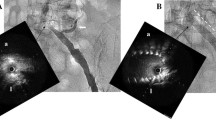Abstract
Stent implantation has been proven to be safe and has become the first-line intervention for May-Thurner syndrome (MTS), with satisfactory mid-term patency rates and clinical outcomes. Recent research has demonstrated that catheter-directed thrombolysis is the preferred strategy when MTS is combined with deep vein thrombosis after self-expanding stent placement. However, the stent used for the venous system was developed based on the experience obtained in the treatment of arterial disease. Consequently, relatively common corresponding complications may come along later, which include stent displacement, deformation, and obstruction. Different measures such as adopting a stent with a larger diameter, improving stent flexibility, and increasing stent strength have been employed in order to prevent these complications. The ideal venous stent is presently being evaluated and will be introduced in detail in this review.
Similar content being viewed by others
References
Eliahou R, Sosna J, Bloom AI. Between a rock and a hard place: Clinical and imaging features of vascular compression syndromes. Radiographics, 2012,32(1): E33–E49
Birn J, Vedantham S. May-Thurner syndrome and other obstructive iliac vein lesions: Meaning, myth, and mystery. Vascular Medicine, 2015,20(1):74–83
Al-Omari MH, Aljarrah QM, Fataftah J, et al. Endovascular management of May-Thurner syndrome in a patient with left-sided superior vena cava: A case report. Am J Case Rep, 2019,20:713–718
Hage AN, Srinivasa RN, Abramowitz SD, et al. Endovascular iliocaval reconstruction for the treatment of iliocaval thrombosis: From imaging to intervention. Vasc Med, 2018,23(3):267–275
Park JY, Ahn JH, Jeon YS, et al. Iliac vein stenting as a durable option for residual stenosis after catheter-directed thrombolysis and angioplasty of iliofemoral deep vein thrombosis secondary to may-thurner syndrome. Phlebology, 2014,29:461–470
Ming ZB, Li WD, Yuan RF, et al. Effectiveness of catheter directed thrombolysis and stent implantation on iliofemoral vein thrombosis caused by iliac vein compression. J Thromb Thrombolysis, 2017,44(2):254–260
Knuttinen, M, Naidu, S, Oklu, R. et al. May-Thurner: Diagnosis and endovascular management. Cardiovasc Diagn Ther, 2017,7(Suppl 3):S159–S164
Hager ES, Yuo T, Tahara R, et al. Outcomes of endovascular intervention for May-Thurner syndrome. J Vasc Surg Venous Lymphat Disord, 2013,1(3):270–275
Murphy E H, Johns B, Varney, E, et al. Endovascular management of chronic total occlusions of the inferior vena cava and iliac veins. J Vasc Surg Venous Lymphat Disord, 2017,5(1):47–59
Chait J, Alsheekh A, Aurshina A, et al. Effect of venous access site on postintervention stent thrombosis for nonthrombotic iliac vein stenting. J Vasc Surg Venous Lymphat Disord, 2020,8(1):84–88
Dasari M, Avgerinos E, Raju S, et al. Outcomes of iliac vein stents after pregnancy. J Vasc Surg Venous Lymphat Disord, 2017,5(3):353–357
Shamimi-Noori SM, Clark TWI. Venous stents: Current status and future directions. Tech Vasc Interv Radiol, 2018,(2):113–116
Kwak HS, Han YM, Lee YS, et al. Stents in common iliac vein obstruction with acute ipsilateral deep venous thrombosis: Early and late results. J Vasc Interv Radi, 2005,16(6):815–822
Razavi MK, Jaff MR, Miller LE. Safety and effectiveness of stent placement for iliofemoral venous outflow obstruction. Circ Cardiovasc Interv, 2015,8(10): e002772
Carroll S, Moll S. Inferior Vena Cava Filters, May-Thurner syndrome, and vein stents. Circulation, 2016, 133(6):e383–e387
Ibrahim W, Al Safran Z, Hasan H, et al. Endovascular management of may-thurner syndrome. Ann Vasc Dis, 2012,5(2):217–221
Butros SR, Liu R, Oliveira GR, et al. Venous compression syndromes: Clinical features, imaging findings and management. Brit J Radio, 2013,86(1030):20130284
Raju S. Treatment of iliac-caval outflow obstruction. Semin Vasc Surg, 2015,28(1):47–53
White JM, Comerota AJ. Venous compression syndromes. Vasc Endovasc Surg, 2017,51(3):155–168
Sudheendra D, Vedantham S. Catheter-directed therapy options for iliofemoral venous thrombosis. Surg Clin N Am, 2018, 98(2):255–265
Raju S, Montminy ML, Thomasson JD, et al. A comparison between intravascular ultrasound and venography in identifying key parameters essential for iliac vein stenting. J Vasc Surg Venous Lymphat Disord, 2019,7(6):801–807
Stuck AK, Reich T, Engelberger RP, et al. Endovascular treatment of post-thrombotic and non-thrombotic iliofemoral venous outflow obstructions with self-expanding nitinol stents. Vasa, 2018,47(4):319–325
Funatsu, A., Anzai, H., Komiyama, K. et al. Stent implantation for May-Thurner syndrome with acute deep venous thrombosis: Acute and long-term results from the ATOMIC (AcTive stenting for May-Thurner Iliac Compression syndrome) registry. Cardiovasc Interv Ther, 2019,34:131
Ibrahim W, Al Safran Z, Hasan H, et al. Endovascular management of may-thurner syndrome. Ann Vasc Dis, 2012,5(2):217–221
Desai KR, Laws JL, Salem R, et al. Defining prolonged dwell time: When are advanced inferior vena cava filter retrieval techniques necessary? An analysis in 762 procedures. Circ Cardiovasc Interv, 2017,10(6):e003957
Kasirajan K, Gray B, Ouriel K. Percutaneous AngioJet thrombectomy in the management of extensive deep venous thrombosis. J Vasc Interv Radiol, 2001,12(2): 179–185
Iyer S, Angle JF, Uflacker A, et al. Venous compression syndromes: a review. Curr Treat Options Cardiovasc Med, 2017,19(6):45
Abdul-Haqq R, Novak Z, Pearce BJ, et al. Routine extended follow-up surveillance of iliac vein stents for iliocaval venous obstruction may not be warranted. J Vasc Surg Venous Lymphat Disord, 2017,5(4):500–505
Attaran RR, Ozdemir D, Lin I, et al. Evaluation of anticoagulant and antiplatelet therapy after iliocaval stenting: Factors associated with stent occlusion. J Vasc Surg Venous Lymphat Disord, 2019,7(4):527–534
Zucker EJ, Ganguli S, Ghoshhajra BB, et al. Imaging of venous compression syndromes. Cardiovasc Diagn Ther, 2016,6(6):519–532
Knipp BS, Ferguson E, Williams DM, et al. Factors associated with outcome after interventional treatment of symptomatic iliac vein compression syndrome. J Vasc Surg, 2007,46(4):743–749
Cho H, Kim JW, Hong YS, et al. Stent Compression in iliac vein compression syndrome associated with acute ilio-femoral deep vein Thrombosis. Korean J Radiol, 2015,16(4):723–728
Lichtenberg MKW, de Graaf R, Stahlhoff WF, et al. Venovo venous stent in the treatment of non-thrombotic or post-thrombotic iliac vein lesions — short-term results from the Arnsberg venous registry. Vasa, 2019,48(2): 175–180
Chick JFB, Srinivasa RN, Cooper KJ, et al. Endovascular Iliocaval reconstruction for chronic iliocaval thrombosis: the data, where we are, and how it is done. Tech Vasc Interv Radiol, 2018,21(2):92–104
Bondarev S, Keller EJ, Han T, et al. Predictors of disease recurrence after venoplasty and stent placement for May-Thurner syndrome. J Vasc Interv Radiol, 2019,30(10):1549–1554
J Padrnos L, Garcia D. May-Thurner syndrome and thrombosis: a systematic review of antithrombotic use after endovascular stent placement. Res Pract Thromb Haemost, 2018,3(1):70–78
Lichtenberg M, De RG, Erbel C. Standards for recanalisation of chronic venous outflow obstructions. Vasa, 2018,47(4):259–266
Xu JS, Liu YJ, Zhou WM. Mid- and long-term efficacy of endovascular-based procedures for Cockett syndrome. Sci Rep, 2018,8(1):12145
Yin SW, Guo LW, Bian L, et al. Evaluation of percutaneous mechanical thrombectomy via the AngioJet system combined with catheter-directed thrombolysis for the treatment of symptomatic lower extremity deep venous thrombosis. Ann Vasc Surg, 2020,65:66–71
Hage AN, Srinivasa RN, Abramowitz SD, et al. Endovascular iliocaval stent reconstruction for iliocaval thrombosis: a multi-institutional international practice pattern survey. Ann Vasc Surg, 2018,49:64–74
Moudgill N, Hager E, Gonsalves C, et al. May-Thurner syndrome: Case report and review of the literature involving modern endovascular therapy. Vascular, 2009, 17(6):330–335
Liu F, Lü P, Jin B. Catheter-directed thrombolysis for acute iliofemoral deep venous thrombosis. Ann Vasc Surg, 2011,25(5):707–715
Bu’Lock FA, Tometzki AJ, Kitchiner DJ, et al, Balloon expandable stents for systemic venous pathway stenosis late after Mustard’s operation. Heart, 1998,79(3):225–229
Tian C, Liu B, Liu J, et al. Comparison of self-expandable stents and balloon-mounted stents in the treatment of symptomatic intracranial vertebral artery atherosclerotic stenosis. Am J Transl Res, 2021,13(3):1607–1616
Wawrzyńska M, Arkowski J, Włodarczak A, et al. Functionalised Cardiovascular Stents. 3-Development of Drug-Eluting Stents (DES). Sawston: Woodhead Publishing, 2018:45–56
Hulsberg PC, Mcloney E, Partovi S, et al. Minimally invasive treatments for venous compression syndromes. Cardiovasc Diagn Ther, 2016,6(6):582–592
Schwein A, Georg Y, Lejay A, et al. Endovascular treatment for venous diseases: Where are the venous stents? Methodist Debakey Cardiovasc J, 2018,14(3): 208–213
Raju S. Best management options for chronic iliac vein stenosis and occlusion. J Vasc Surg, 2013,57(4):1163–1169
Xue GH, Huang XZ, Ye M, et al. Catheter-directed thrombolysis and stenting in the treatment of iliac vein compression syndrome with acute iliofemoral deep vein thrombosis: Outcome and follow-up. Ann Vasc Surg, 2014,28(4):957–963
Mando R, Sigua-Arce P, Spencer L, et al. Slippery stents: a case report and review of the literature describing patients with May-Thurner syndrome that experienced stent migration. Case Rep Vasc Med, 2019,2019: 7606727
Elmahdy S, Shults CC, Alhaj Moustafa M. An unusual cause of acute heart failure: a case report of iliocaval venous stent migration. J Investig Med High Impact Case Rep, 2018,6:2324709618799118
Gordon BM, Fishbein MC, Levi DS. Polytetrafluo-roethylene-covered stents in the venous and arterial system: angiographic and pathologic findings in a swine model. Cardiovasc Pathol, 2008,17(4):206–211
Hsieh MJ, Huang YC, Yeh JK, et al. Predictors of long-term outcomes after drug-eluting balloon angioplasty for bare-metal stent restenosis. Heart Lung Circ, 2017, S1443950617304857
Jayaraj A, Buck W, Knight A, et al. Impact of degree of stenosis in May-Thurner syndrome on iliac vein stenting. J Vasc Surg Venous Lymphat Disord, 2019,7(2):195–202
Neglén P, Raju S. In-stent recurrent stenosis in stents placed in the lower extremity venous outflow tract. J Vasc Surg, 2004,39(1):181–187
Radaideh Q, Patel NM, Shammas NW. Iliac vein compression: Epidemiology, diagnosis and treatment. Vasc Health Risk Manag, 2019,15:115–122
Khairy SA, Neves RJ, Hartung O, et al. Factors associated with contralateral deep venous thrombosis after iliocaval venous stenting. J Vasc Surg, 2018,67(1):358–359
Erben Y, Bjarnason H, Oladottir GL, et al. Endovascular recanalization for nonmalignant obstruction of the inferior vena cava. J Vasc Surg Venous Lymphat Disord, 2018,6(2):173–182
Jayaraj A, Powell T, Raju S. Utility of the 50% stenosis criterion for patients undergoing stenting for chronic iliofemoral venous obstruction. J Vasc Surg Venous Lymphat Disord, 2021,9(6):1408–1415
Raju S, Ward M Jr, Kirk O. A modification of iliac vein stent technique. Ann Vasc Surg, 2014,28(6):1485–1492
Bu’Lock FA, Tometzki AJ, Kitchiner DJ, et al. Balloon expandable stents for systemic venous pathway stenosis late after Mustard’s operation. Heart, 1998,79(3):225–229
Ward CJ, Mullins CE, Nihill MR, et al. Use of intravascular stents in systemic venous and systemic venous baffle obstructions. Short-term follow-up results. Circulation, 1995,91(12):2948–2954
Murphy EH, Johns B, Varney E, et al. Deep venous thrombosis associated with caval extension of iliac stents. J Vasc Surg Venous Lymphat Disord, 2017,5(1):8–17
van Vuuren TM, de Wolf MA, Wittens CH. Relevance of flexibility versus radial force in rigid versus more flexible venous stents? Phlebology, 2019,34(7):459–465
Baquet M, Nef H, Gori T, et al. Restenosis patterns after bioresorbable vascular scaffold implantation: Angiographic substudy of the GHOST-EU registry. Catheter Cardiovasc Interv, 2018,92(2):276–282
Shen D, Qi H, Lin W, et al. PDLLA-Zn-nitrided Fe bioresorbable scaffold with 53-µm-thick metallic struts and tunable multistage biodegradation function. Sci Adv, 2021,7(23):eabf0614
Ni L, Chen H, Luo Z, et al. Bioresorbable vascular stents and drug-eluting stents in treatment of coronary heart disease: a meta-analysis. J Cardiothorac Surg, 2020,15(1):26
Abdullah K, Bou Dargham B, Steinbrecher M, et al. Drug-eluting stents for treatment of peripheral artery disease. Am J Cardiovascular Drugs, 2018,18(3):175–180
Lichtenberg M, Breuckmann F, Stahlhoff WF, et al. Placement of closed-cell designed venous stents in a mixed cohort of patients with chronic venous outflow obstructions — short-term safety, patency, and clinical outcomes. Vasa, 2018,47(6):475–481
Author information
Authors and Affiliations
Corresponding author
Additional information
Conflict of Interest Statement
The authors have declared that they have no conflicts of interest.
This work was supported by grants from the National Natural Science Foundation of China (No. 81670512 and No. 81101042) and the Natural Science Foundation of Hubei Province, China (No. 2016CFB378).
Rights and permissions
About this article
Cite this article
Liu, Q., Liu, F., Lü, P. et al. Current Status and Prospect of Stent Placement for May-Thurner Syndrome. CURR MED SCI 41, 1178–1186 (2021). https://doi.org/10.1007/s11596-021-2481-4
Received:
Accepted:
Published:
Issue Date:
DOI: https://doi.org/10.1007/s11596-021-2481-4




